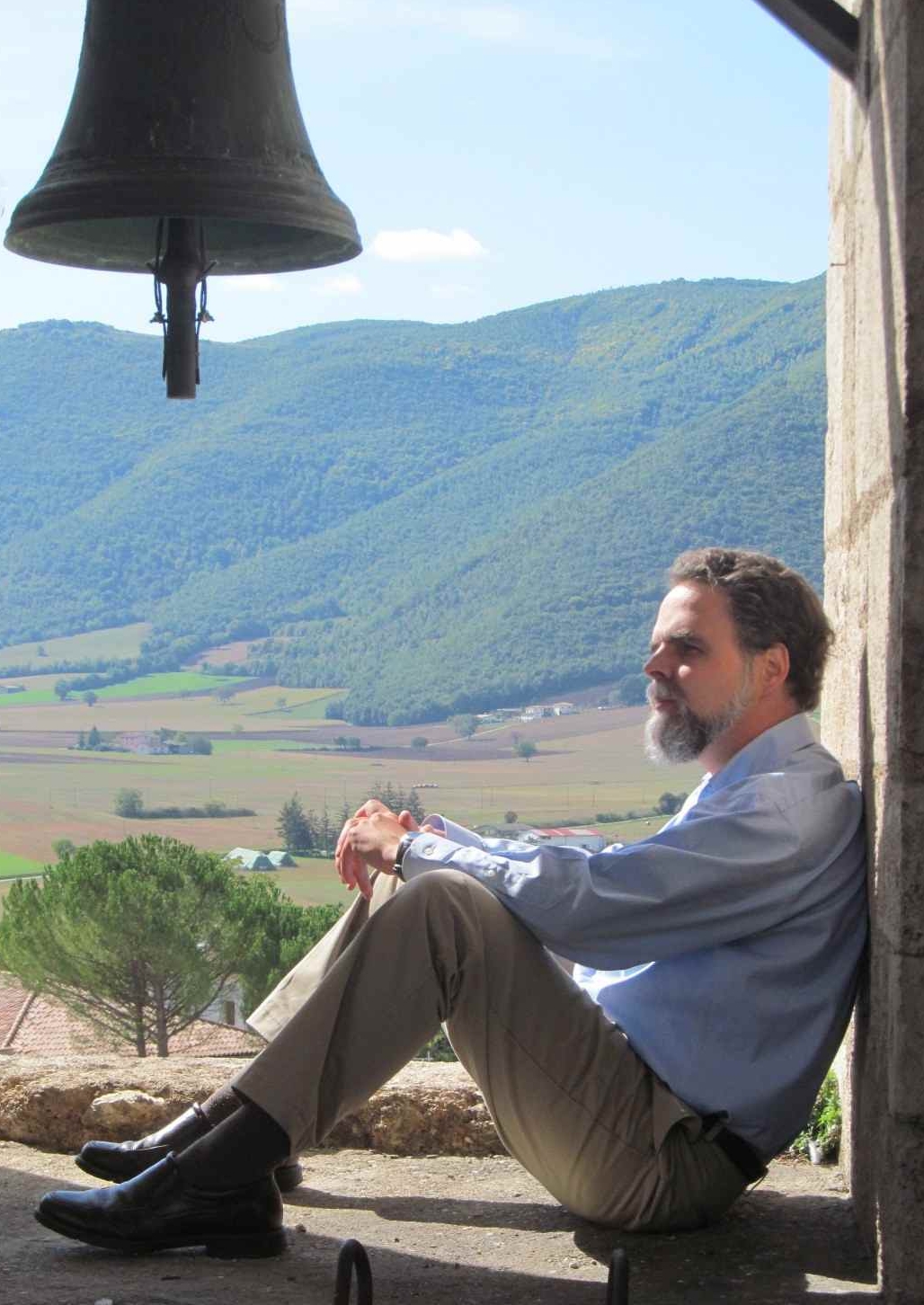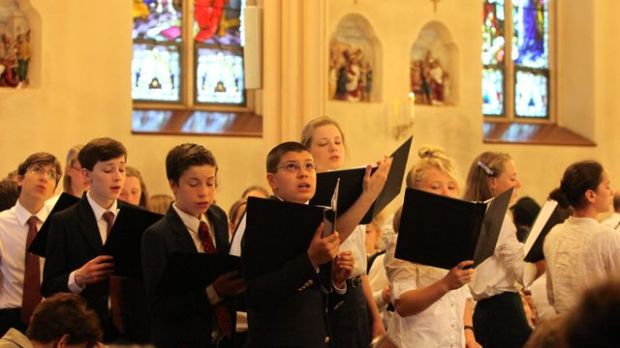NORCIA, ITALY — Recently in Norcia, Italy, during the summer theology program offered by the Albert the Great Center for Scholastic Studies, I was able to catch one of the tutors, Peter Kwasniewski, for an in-person interview. Dr. Kwasniewski is a Professor of Theology at Wyoming Catholic College and also a cantor, conductor, and composer of sacred music.

Dr. Kwasniewski, can you tell me something about your background in church music?
I’ve been composing music for about 25 years, mostly sacred choral music but also instrumental works and a few secular works. My first serious lessons in composition and conducting took place with a wonderful teacher, Roy Horton, now deceased, who was organist at Delbarton School in Morristown, New Jersey. I fell madly in love with music and threw myself at it more than at any other subject up until that point. When I arrived at Thomas Aquinas College, I had the good fortune to be asked by the main choir director, who lived quite a distance from the college, to be the assistant choir director. I started leading choir practices and even leading the choir at Mass on Sundays. It was a kind of total immersion experience, like being thrown into the deep end of the pool without knowing how to swim very well. But the four years in college of working intensively with the choir really fired my imagination.
Can you be more specific about what it was that fired your imagination?
What was appealing to me was Gregorian chant and classical polyphony. In college I was in the schola for four years and sang the proper chants of the Mass, Sunday after Sunday. We also sang polyphonic Mass ordinaries and motets. That was my first serious acquaintance with sacred music: singing Palestrina, Victoria, Byrd, the great Renaissance composers. I suppose you could say I had really good models to work with and I tried to imitate them in my own compositions, although they were clumsy at first. With trial and error, through study and hard work, I finally got to a point some time after I graduated where I was writing music choirs wanted to sing and I felt confident in putting it forward.
Someone could raise the objection: why don’t we just sing chant and Palestrina? The composers of this music, whether anonymous or named, are clearly geniuses and we can’t equal their work, so why bother?
There’s nothing wrong, of course, with continually going back to the classics of the past; the [Second Vatican] Council says we should do that. But every generation should have something beautiful that it can add to the treasury, because every generation wants to make an offering to God. That’s why the Council says that Catholic composers, inspired by the past, should make their own contribution to the store of the arts. Another way to look at it is that modern works of art can (and should) have a certain modern feel to them, so that they seem to emerge from and speak to our age. For instance, contemporary composers make use of harmonies that are more adventurous, that go beyond the rules of earlier centuries—think of the music of Arvo Pärt, or Morten Lauridsen, or Frank La Rocca. It’s beautiful music but distinctively modern.
Isn’t there a danger, though, with modern music—that it can alienate listeners? Maybe by being too dissonant?
Yes, for sure, we have struggled with that problem, although the atonal revolution of the 20th century has mostly died out by now, and the “new tonality” has taken its place. Any church composer worth his salt understands that one has to have a certain “conservatism” when writing sacred music. Whatever is “modern” in the piece should not overshadow the whole character of it so that it seems only modern and cut off from the past. The past offers us perennially vibrant models. If you look at the great composers and sculptors and architects of the past, they did the same thing. None of them ever tried to start from scratch. They were always building off of the models that came before. That’s part of the humility of a great artist. It’s standing on the shoulders of giants. If you’re a composer, you try to learn from the great composers; you don’t ignore them and think you can do better than they have done. I find it extremely energizing, this constant dialogue between past and present, between masterpieces that set the bar high and our own efforts to enrich the repertoire.
What motivates you to write a particular piece of sacred music?
Often there is a particular liturgical need for a piece, perhaps a simpler setting because it will be quicker or easier to learn with amateur choristers—and when you’re singing week after week and don’t have a lot of rehearsal time, that’s very helpful.
Can you say something about the creative process?
Creativity is not something that’s on tap like beer. If you produce something like that, it will be pedestrian and uninspired, more like an exercise or a homework assignment. A piece of music that is going to touch people is something that’s a gift. And you just have to keep putting yourself in the way of that gift. I think it’s like the Christian life in general. You work as hard as you can to dispose yourself for God’s grace, but in the end you know that it’s going to be a gift from Him, and you can’t claim it or demand it. Practically speaking, I need a block of free time, a quiet house, a piano, a music notebook, and a good pencil with a good eraser. I like to scribble down ideas, motifs, chords. Often it will take a few years to finish a piece. The draft sits around for a while before I see the overall direction it needs, or the finishing touches. In a few happy cases, a strong idea turns into a complete piece in a day or two. But that’s pretty rare.
Is your music published and available for those who are interested?
A couple of years ago, under the aegis of Corpus Christi Watershed, I published a volume called Sacred Choral Works, which contains over 80 compositions of varying lengths for all the seasons of the Church year, mostly for four-part choir (Soprano-Alto-Tenor-Bass), but in a few cases for three-part choir (Soprano-Alto-Bass) or equal voices (Soprano-Soprano-Alto/Tenor-Tenor-Bass). Some pieces are in Latin, others in English, so there’s a variety for both the Ordinary Form and the Extraordinary Form, and always following the ideals of the Church’s Tradition and the Church’s Magisterium. At my YouTube channel there are sample pieces and scores, for those who are interested in having a listen and a look.
Are you working on any big musical projects at this time?
Yes, two as a matter of fact.
A gentleman from Austria wrote a letter to me a few months ago to thank me for the Sacred Choral Works. He floated the idea of a polyphonic Mass and set of Propers for the principal Marian feast of Innsbruck, which is always celebrated the first Saturday of July. After we agreed on the feasibility of the project, he commissioned me to write the eleven compositions—Kyrie, Gloria, Credo, Sanctus, Agnus Dei, Introit, Gradual, Alleluia, Offertory, and Communion—for a premiere on July 1, 2017, in Innsbruck. Naturally, that’s a wonderful project to be working on, and will keep me busy in the months to come.
The other project is also very exciting. A choir director in Chicago who had come to appreciate my sacred music proposed that we hold a public concert with professional singers, and in tandem with the concert, make a recording and produce a CD. In order to fund this, he launched a Plumfund campaign that is doing well so far (but needs a little bit more to push it to the goal). The concert will take place in Chicago in June 2017, with the details to be announced shortly. It would be hard to exaggerate how special it is to have such a concert and recording to look forward to. Music doesn’t really exist on paper; on the paper you have only symbols of it. The music exists when it is being performed. This is why Arvo Pärt says that musicians are “co-composers” with the composer.
What can people expect from the upcoming concert in Chicago?
As I mentioned earlier, I’ve written a lot of simple pieces that any choir can sing, and many of those are in the book Sacred Choral Works. But I’ve also written a fair number of more challenging pieces that only a professional choir could sing, just because they’re more demanding in terms of vocal technique and the harmonies used. The choir would need to be expertly trained to get them exactly right. The concert is going to feature those pieces, which I might consider better works of art, but less accessible to an amateur choir. We’ll do a Mass, some motets, and hymns, works in Latin and in English. Then, we’ll record a CD of this concert program and make it available online.
I think it will be a splendid opportunity to demonstrate that sacred music is alive and well—that worthwhile new things can come from age-old ideals. It is a privilege to be able to serve Our Lord and His Church in this way.
Read Part II of our interview with Dr. Peter Kwasniewski, on the Church’s teaching on sacred music over the past 100 years and some of the challenges it faces today, here. Read the final part of our interview, on how to introduce good sacred music into your parish, here.
Diane Montagna is Rome correspondentfor Aleteia’s English edition.
[Editor’s Note: Take the Poll – Is Sacred Music easier to pray to?]

